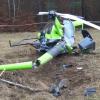Niugini AT42 at Madang on Oct 19th 2013, overran runway on rejected takeoff
An Air Niugini Avions de Transport Regional ATR-42-300, registration P2-PXY performing a freight flight from Madang to Tabubil (Papua New Guinea) with 3 crew, rejected takeoff from Madang's runway 25, but overran the end of the runway and came to a stop in the waters of the Meiro Creek at about 09:00L (23:00Z Oct 18th). All three crew were able to exit the aircraft through the cockpit escape hatches, one received minor injuries, all three crew have been released from hospital already. The aircraft received substantial damage.
Papua's Minister of Civil Aviation confirmed P2-PXY was involved in an accident today (Oct 19th) at Madang airport stating "THE CARGO AIRCRAFT (REGISTRATION MARK P2-PXY) OVERRAN THE WESTERLY RUNWAY AND CAME TO REST IN MEIRO CREEK OFF THE END OF RUNWAY 25". Three crew members were on board at the time of the accident, one received minor injuries, all crew has been taken to medical facilities for further assessment and treatment. The aircraft received damage to the right hand wing and engine due to fire. An investigation team has been launched on site. The Minister especially thanked rescue services for their prompt response to the accident. The aircraft belongs to Farn Air and was leased out to Air Niugini being operated on Air Niugini's AOC.
An observer on the ground reported the aircraft overran the end of the runway while attempting to take off.
On Oct 22nd 2013 the French BEA reported in their weekly bulletin that the aircraft accelerated for takeoff from runway 25 when upon rotation the nose gear did not lift off the runway, the captain, pilot flying, said in post flight interviews the controls felt very heavy in pitch. The captain rejected takeoff, the aircraft overran the end of the runway, went down a bank of about 3 meters, continued for about 100 meters before the right wing impacted the airport perimeter fence, causing the aircraft to turn about 45 degrees, right hand engine and right outboard wing caught fire, the aircraft slid down into a small creek where it came to rest partly submerged. The cockpit voice and flight data recorder were not submerged and were recovered in good condition. The right hand engine separated from the wing and fell into the creek. The investigation is led by the Authorities of Papua New Guinea.
On Dec 13th 2013 Papua New Guinea's Accident Investigation Commission (PNGAIC) released their preliminary report stating that the aircraft had an anti-skid light illuminating prior to departure from Port Moresby to Madang. The crew stopped the aircraft, worked the relevant checklists and assessed that it was permissable to depart with the anti-skid inoperative. On the ground in Madang a load of cigarettes in large cardboard cartons was loaded.
The aircraft departed runway 25 with the captain (37, ATPL, 7,110 hours total, 3,433 hours on type) being pilot flying and the first officer (33, ATPL, 3,020 hours total, 2,420 hours on type) being pilot monitoring. Full length of the runway was used, Vr had been computed at 102 KIAS. The captain reported, that upon rotation the controls felt very heavy in pitch and he could not pull the column back the normal way. About 2 seconds after attempting rotation the captain rejected takeoff selecting full reverse thrust and applying full braking, however, it was not possible to stop the aircraft before the end of the runway. The aircraft went over an embankment at the end of the runway, the right wing struck the perimeter fence causing the aircraft to yaw to the right. The aircraft went into a creek at an angle of about 45 degrees to the extended runway center line. The right outboard wing section caught fire, the crew left the aircraft through the escape hatch at the top of the cockpit. Just before leaving the captain, exiting the aircraft last, discharged the fire extinguishers into both engines and switched off the battery master switch.
The PNGAIC reported: "The Madang Airport Fire and Rescue Service responded promptly and a fire truck began to spray the fire in the right wing with foam and water. The foam and water were exhausted before the fire was fully extinguished but the fire did not spread to the right inboard wing section. Almost immediately after the accident, local people entered the aircraft through the hatch in the cockpit roof and the right door at the rear of the fuselage and began removing items from the cockpit and the cargo compartments." and later stated: "It was not possible to determine the actual distribution of cargo in the aircraft after the accident because of the large number of cartons removed by local people before the investigation began. The client estimated that approximately 30 to 35 % of the cargo was removed in this way."
According to the loadsheet 3,710kg of cigarettes were loaded in 400 cartons distributed amongst cargo departments (see sketch below) at: A=350kg, B,C,D=800kg, E=600kg and F=360kg. However: "The operator’s cargo supervisor stated after the accident that PXY had been loaded on the assumption that each carton weighed 12 kg, but that the cartons had not been weighed before they were loaded onto the aircraft. The client, who had manufactured and packed the cigarettes, provided average carton weights to the AIC on the basis of samples of 25 cartons of each of the three carton types loaded on PXY."
No weather data are available.
Madang Airport offers a runway 07/25 of 5170 feet/1580 meters length.
Maximum load capacity (Graphics: PNGAIC):
Ground marks (Photo: PNGAIC):
Aerial overview (Photo: PNGAIC):
Aftermath (Photo: Andrea):
Immediately after the accident before arrival of emergency services (Photo: wanaku):
Map (Graphics: AVH/Google Earth):
http://avherald.com/h?article=46a2b3ac














Komentarze